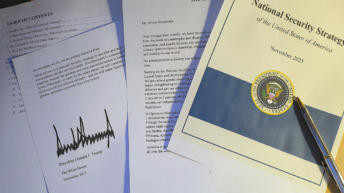
Introduction
India has long faced a complex and challenging strategic environment. The current landscape is shaped by rising great-power rivalries, China’s growing influence, intensifying US-China competition, and shifting global power dynamics. Regionally, security concerns arise from border disputes with China, adversarial relations with Pakistan—including its support for terrorism in India—and increasing cyber threats. Rising border tensions, the rapid spread of unmanned aerial systems, and precision-guided munitions emphasise the urgent need for a robust, layered defence system. Lessons from Operation Sindoor, where India effectively employed counter-drone systems, surface-to-air missiles, and electronic warfare against saturation raids from Pakistan, demonstrated the potency of layered, indigenous defence and confirmed India’s capacity to expand such a concept nationwide. It is within this context that Prime Minister Narendra Modi announced Mission Sudarshan Chakra, an ambitious initiative to establish a comprehensive, multi-layered, indigenous defensive shield for India by 2035—a significant step in national defence.
Prime Minister Modi compared the mission to the legendary Sudarshan Chakra of Lord Krishna, recalling its role in the Mahabharata when Krishna used it to block the Sun’s rays, allowing Arjun to fulfil his vow of slaying Jayadratha. The symbolism encapsulates the mission’s core theme of protection and deterrence. Similar to Israel’s Iron Dome, Mission Sudarshan Chakra aims to provide India with an indigenous shield capable of neutralising a broad range of threats. It demonstrates India’s intention to protect population centres, strategic assets, and civil infrastructure from dangers such as ballistic missiles, drone swarms, and cyber-enabled hybrid warfare.
Mission Sudarshan Chakra aims to establish a nationwide security shield to thwart enemy attacks across different domains. It seeks to enhance India’s deterrent and offensive capabilities by developing an advanced, multi-tiered air defence system through:
- Integrated air defence, missile defence, counter-drone technologies, cyber protection, and civil defence measures.
- Providing layered protection for strategic assets and civilian infrastructure.
- Ensuring strategic autonomy through full indigenisation of R&D and manufacturing.
- Achieving nationwide coverage by 2035.
The Indian Experience in Operation Sindoor
Operation Sindoor showcased the effectiveness of India’s Integrated Air Defence (IAD) in countering Pakistan’s large-scale UAV and loitering munitions offensive. Coordinated through the IAF’s IACCS and the Army’s Akashteer, which fused radar and sensor data into a unified Recognised Air Situation Picture (RASP), the operation demonstrated seamless jointness. India employed a layered defence system integrating indigenous and advanced platforms as follows:
- The Akash Missile System (AMS) neutralised drones and missiles.
- The MRSAM countered multiple aerial threats, and the S-400 destroyed high-altitude targets.
- Anti-drone measures: The DRDO’s D4 CUAS, laser-based jammers, and EW rifles proved decisive against swarms.
- Modernised legacy assets, such as the Pechora SAM, L70 guns with Flycatcher radars, and Shilka systems, reinforced low-altitude defence.
Operation Sindoor thus underlined India’s growing ability to combine kinetic, non-kinetic, and electronic warfare assets into a resilient, multi-layered shield.
The outermost, fourth layer was anchored by the S-400 Triumf (Sudarshan Chakra), India’s most advanced interceptor system. Equipped with the 91N6E Big Bird long-range advanced detection radar and the 92N6E Grave Stone fire-control radar, each capable of tracking up to 80 targets and engaging 12 simultaneously, providing strategic depth against high-altitude aircraft, ballistic and cruise missiles. The third layer, covering the mid-range, employed Medium-Range Surface-to-Air Missiles (MRSAMs) with a range of 70 km. Operated by both the Army and Air Force, these systems formed a versatile shield against drones, cruise missiles, and fighter jets.
The second layer was designed for short-range engagements and comprised the Israeli Spyder and the indigenous Akash system. Spyder, with a 15–20 km range, employed Python-5 infrared missiles and Derby radar-guided missiles, enabling rapid reaction against low-flying aircraft and drones. The Akash, with a 25–30 km range, was highly effective against supersonic targets through mid-course updates and proportional navigation.
The innermost, first layer provided terminal defence within 10 km. It included Close-in Weapon Systems (CIWS), mobile SAMs (OSA-AK-M, Strela-10M), Tunguska, Shilka, upgraded legacy guns like the 40mm L70 and ZU-23 and MANPADS such as the Igla-M and Igla-S, adding another tier of low-level protection. To counter evolving drone threats, indigenous systems like DRDO’s D4 CUAS (Counter-Unmanned Aerial System), laser jammers, and EW rifles were deployed, ensuring no aerial threat slipped through the layered grid.
Envisaged Capabilities and Architecture of Sudarshan Chakra
Although the exact details of Mission Sudarshan Chakra have not yet been disclosed, it is widely expected to be an Iron Dome–like system with significantly more advanced capabilities. The Prime Minister’s speech outlined its general framework: a modern, comprehensive, multi-layered, and networked defensive shield designed to protect India and its vital installations—both strategic and civilian—against multi-domain threats. Unlike traditional defence systems, Sudarshan Chakra is anticipated to also have an offensive component, allowing for precision strikes alongside attack neutralisation. The shield will offer layered protection by integrating surveillance, cybersecurity, and a broad range of air defence systems, capable of countering long-range missiles, aircraft, and unmanned aerial vehicles along the borders and around key infrastructure.
A defining feature will be its sensor grid, built from a fusion of space, air, and ground-based sensors, capable of detecting not only conventional missiles but also stealth platforms and hypersonic vehicles. Entirely developed under the ‘Make in India’ initiative, the programme will rely on indigenous research, development, manufacturing, and upgrades. Cutting-edge technologies such as artificial intelligence (AI), directed-energy weapons, lasers, and drones will form the core of the system. In essence, Sudarshan Chakra will be India’s counterpart to Israel’s Iron Dome and the proposed US Golden Dome, but tailored with enhanced, future-ready capabilities.
Mission Sudarshan Chakra will thus be an advanced, multi-tiered air and missile defence system, comprising the following:
- Surveillance and Detection: Long-range radars, space-based sensors, and civilian-military radar fusion.
- Kinetic Defence: Akash-NG, MRSAM, and future hypersonic interceptors for neutralising missiles, UAVs, and aircraft.
- Non-Kinetic Defence: Directed energy weapons, electronic warfare, and cyber countermeasures.
- Integrated C2 Network: AI-enabled decision-making with seamless tri-service coordination.
- Civil Defence Layer: Public safety measures ensuring the resilience of critical infrastructure and urban centres.
Present Status
In January 2025, DRDO unveiled its security architecture proposal, ‘Raksha Kavach’. A tableau showcasing this vision was also displayed during the Republic Day Parade under the theme “Raksha Kavach – Multi-layer Protection against Multi-domain Threats.” It highlighted a range of indigenous systems, including the Quick Reaction Surface-to-Air Missile, Airborne Early Warning & Control System, 155 mm/52 Cal Advanced Towed Artillery Gun System, Drone Detect–Deter–Destroy technologies, Satellite-Based Surveillance, Medium Power Radar Arudhra, Advanced Lightweight Torpedo, Electronic Warfare System Dharashakti, Laser-Based Directed Energy Weapon, Very Short Range Air Defence System, Indigenous Unmanned Aerial System, V/UHF Manpack Software Defined Radio for land forces, Indigenous Secure Satellite Phone, and the UGRAM Assault Rifle.
Parallelly, DRDO is advancing ‘Project Kusha’, an indigenous long-range surface-to-air missile (LR-SAM) programme. Targeted for completion by 2028–29, it will deploy interceptors with ranges of 150 km, 250 km, and 350 km, designed to rival the S-400. The project represents a significant stride toward self-reliance in long-range air defence. These technologies, already under development, form the foundation that must be integrated with the envisioned capabilities of Mission Sudarshan Chakra and taken forward in a consolidated manner.
Conclusion
Mission Sudarshan Chakra marks a significant advance in India’s defence stance. Once completed, it will deliver a fully integrated, indigenous defence system capable of intercepting ballistic missiles, drones, aircraft, and cyber threats across the country. More than just a technological effort, it is a testament to resilience, self-reliance, and strategic determination, guaranteeing India’s skies remain protected in a progressively unstable security climate.
References:
CUAS and Air Defence Triumph in Operation Sindoor, Squadron Leader Sriram Rajan, 04 June 2025 https://capsindia.org/cuas-and-air-defence-triumph-in-operation-sindoor/
Inside India’s Air Defence Network That Stood Tall During Operation Sindoor, Prakhar Gupta, 13 May 2025,
https://swarajyamag.com/defence
CUAS and Air Defence Triumph in Operation Sindoor, Squadron Leader Sriram Rajan, 04 June 2025 https://capsindia.org/cuas-and-air-defence-triumph-in-operation-sindoor/
https://www.pib.gov.in/PressReleasePage.aspx?PRID=2095372 dt 23 January 2025
Inside India’s Air Defence Network That Stood Tall During Operation Sindoor, Prakhar Gupta,13 May 2025, https://swarajyamag.com/defence/






Add comment